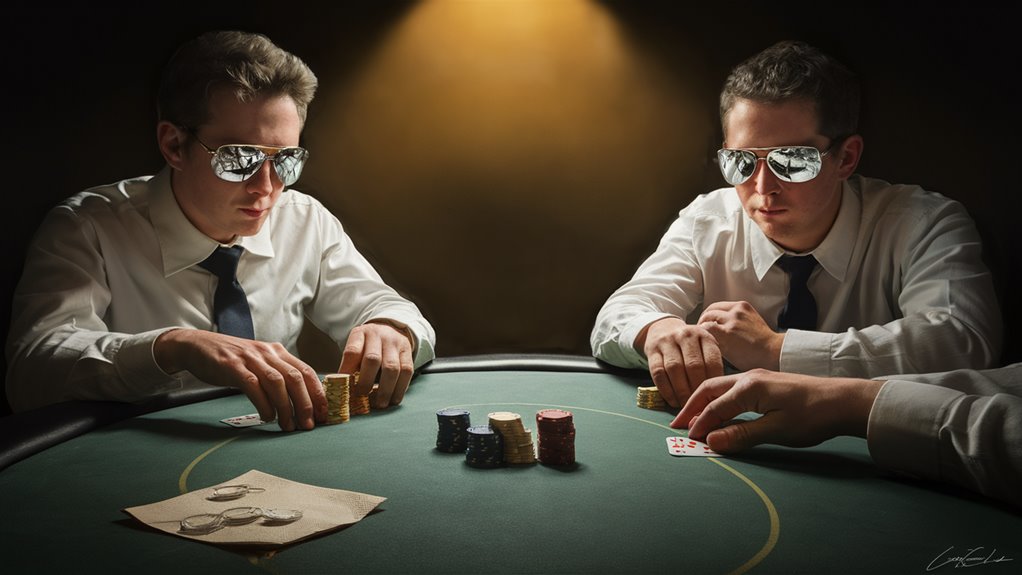
Advanced Reed & Rumor: Poker Table Intelligence
Poker Table: Gathering Information Strategically
Early Poker Anything to Silence a Voice (Play to silent ears) Poker reed techniques and rumor analysis (posture) Poker evokes a game of Vampires to perpetuate a silence where they can not exist. Building precise opponent profiles, transparent by micro-expressions, betting patterns, and table talk allows for finely-tuned adjustments to exploit predictable behavior.
Turning Table Talk into Tactical Advantage
They are experts at turning idle chit chat into intel. Key elements include:
- Tracking how fast a player can react
- Recording rise and fall of behavioral patterns
- Analyzing betting sequences
- Taking words and matching them with actions
Techniques of Profound Psychological Profiling
Modern poker success means you have to create comprehensive dossiers on players as you systematically observe them. Anecdotalists elite players develop intricate systems for:
- Tracking emotional responses
- Recognizing signs of deceit
- Mapping betting tendencies
- Recording psychological tells
And the Science of the Table Talk
Poker Table Talk: The Psychological Edge in Poker
What They Didn’t Teach You in Grad School (Or Elsewhere) About Strategic Table Talk
One of poker’s most potent psychological weapons for stealing relevant information from adversaries is table talk. Players engage in strategic conversation, applying core principles of behavioral psychology to disclose betting patterns, hand strength, and emotional states.
The objective is to fashion perfectly finely tuned and calibrated sonic stimuli that trigger reflexive responses deep into the unconscious.
Interpretation of Micro-Expressions and Body Language
Detail micro-expressions during the Hand discussions reveal telltale signs about the psychological pressure players are under.
Conceptual discussions on what happened on previous plays or hypothetical situations yield rich data on decision behavior. Key indicators include:
- Changes in vocal pitch
- Variations in speech rate
- Shifts in body positioning
- Non-verbal cues and gestures
Creating Your Table Persona
There is a strategy associated with table 온카스터디 talk that takes years of hard-won experience and that is the ability to maintain the same verbal patterns inside and outside of the hand.
Create a natural table presence: gather information while hiding personal tells.
Expert players balance:
- Information extraction
- Strategic misdirection
- Natural conversation flow
- Psychological manipulation
Reading Social Cues Between Hands
Between-Hand Poker Psychology — All In
Listening Social Dynamics During Hand Breaks
For advanced poker players, vital behavioral intel is revealed in the gap between action between hands. Such natural breaks yield invaluable intelligence about opponents’ mental states, emotional reactions, and future actions.
Key Behavioral Indicators
These interactions come to light during downtime, when players take a break from their physical presence with one another, and opponents think they’re not being watched, exposing the genuine emotional state of the players involved.
Look out for these telltale actions:
- Chip manipulation patterns
- Mobile device engagement
- Fiery Table Force
- Table conversation dynamics
- Physical positioning shifts
Identifying Shifts in Behavioral Patterns

Sudden behavioral shifts between hands often indicate significant psychological shifts:
- A usually chatty player growing silent indicates possible tilt
- Stack-related anxiety is hiding behind increased socialization
- Indicates capacity for emotional processing: post-hand reactions
- The velocity of recovery from losses shows mental toughness
Analysis of Body Language and Position
The positional data between physical hands is a valuable piece of strategic information:
- Changes in posture after losses often reflect confidence levels
- Staying in your lane indicates strong emotional regulation
- Well, it reads as a performance trend.
- Patterns in aggression can be predicted through spatial adjustments
Step 1: Constructing Opponent Profiles
How to Create Successful Poker Profiles of Your Opponents
Essential Profile Components
It starts with recording your opponents’ fundamental strategies over many sessions. Monitor key metrics such as:
- Pre-flop raise frequency
- Continuation bet percentages
- Position-based tendencies
- Stack size adjustments
Data Collection Framework
First, baseline behavioral profile at neutral gameplay situations. Track critical deviations when enemies are confronted by:
- High-pressure scenarios
- Significant bankroll swings
- Multi-way pots
- Different stack depths
Advanced Pattern Recognition
Although many things can be said in poker, timing tells offer the most important indications about hand strength pattern:
- Overnight calls generally signal medium-strength positions
- Extended tanks often convey strong ranges
- Differences in bet sizing over multiple streets
- Three-bet response tendencies
Statistical Requirements
Create profiles as per minimum sample sizes:
- 100+ hands for first cut
- More than 500 hands for verifiable statistics
- Every situation, 1000+ hands for impeccable strategizing
Exploitable Tendencies
Identify the adjustment opportunities that will be the most profitable:
- Fold Too Often to River Aggression
- Loose big blind defense patterns
- Stack dependent aggression levels
Pulls like this away from the tilted position are called recovery form, and that means the sensor triggers when the ball is not in the middle.
Turning Gossip Into Strategic Decisions
Using Poker Gossip to Your Advantage
What Is Table Intelligence?
Information gathering at the poker table comes not only from direct observation. Although you need to have your own firsthand experience to build behavioral profiles, table talk and secondhand intelligence can play an important role in the decision-making process.
Winning players manneristically metaphorically calculate the probability weight to each piece on the board according to the Edition and the credibility of veracity of the source.
Analyzing Player Information
Data validation starts with comparing these reported patterns to personal experience to glean a sense of credibility.
Anything that is actionable intelligence impacting to focus on:
- Pot odds calculations
- Expected value adjustments
- Range modifications
Leveraging Table Talk
Among player chatter, extract info that can change perspectives → impact strategy. For instance, if credible reports suggest your opponent has a leaning towards overvaluing suited connectors, adapt your 3-betting range to reflect that.
Be mindful of more than just the surface during casual chit-chat, players frequently expose their true behavioral habits without being aware to do so.
Navigating Competing Information
Systematically track contradictory reports by:
- Becoming aware of situational triggers
- Personality and separate confidence levels
- Behavioral variance monitoring
For any event, for a final brain out of actions, use such a sequence of acts.
- Betting patterns (most confident)
- Leaning toward selecting certain hands (85% confidence)
- Tilt factors (confidence variable)
Reed Techniques In Action
A Comprehensive Strategy Guide on Advanced Poker Reed Techniques
The Three Layers of Reed Analysis Explained
Advanced poker reed techniques hinge on three key elements: observation, interpretation, and exploitation.
Learning these aspects in order gives you an incredibly good foundation for reading your opponents and will give you a huge advantage when you get to the poker table.
Layer 1: Strategic Observation
The basis for player profiling is the careful tracking of:
- How all-in betting changes based on pot size
- The timing tells in decision-making
- Bodily responses to different boards’ surfaces
- A measure indicating deviation from baseline behavior
Layer II: Somewhat More Advanced Interpretation
Psychological assessment must correlate real-time data with recognized indicators:
- Anomalies in response time from baseline
- Deviations in bet sizing under pressure
- Non-verbal signals at key inflection points
- Timing reveals information at crucial moments
Tactical Exploitation (Layer 3)
The implementation of counter-strategy emphasizes using detected patterns:
- Trap against aggressive bluffers
- Continuation betting against players that are tight post-flop
- Exploiting known seasonalities based on position

